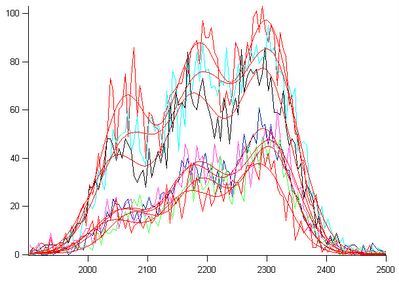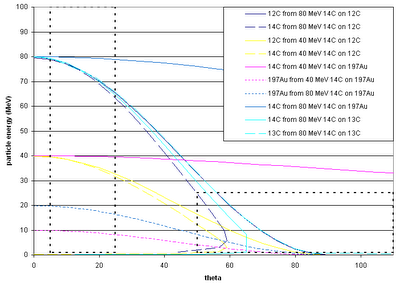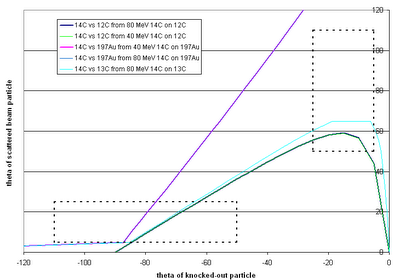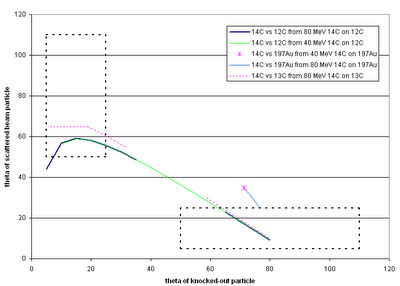1. Data analysis.
- I have a working sort code, with various bells and whistles, including the ability to count the number of "good strips"--if a strip in det 1 has a good energy signal in both ends, the good strip count for det 1 is incremented. Similarly for the quad.
- I have reasonable gain-match parameters for detectors 2,3, and 4. Detector 5 may not have been biassed, and the gain-matching parameters look dodgy. These parameters are derived from the alphas--since we irradiated only the quad, the only way to gain-match detector 1 will be elastic scattering.
- I sorted the data for the alpha run and extracted the energy spectra of all the individual strips. Here's the results, for several of the better strips for one of the better detectors...

The energy spectra for several strips are displayed (jaggedy coloured lines) together with triple-Gaussian fits (red smooth lines) courtesy of Igor. X axis is channel number, not keV. (These spectra are for an intermediate stage in gain-matching, and were used to obtain the final parameters: the parameters were adjusted so that the centroids of the fitted peaks were all the same.) What emerges from these spectra is that the detectors have an energy resolution with σ=110 keV.
UPDATE: Here are simulations done using that value for the detector resolution, compared with a few of the better strips' data. The agreement is decent.

- The actual data...well, various different ways of sorting are presented pell-mell in this previous blog entry. Basically, the most conspicuous feature in the quad energy-position spectra is either noise or an artefact of the joining boards. As to which sorting option is the best, see...
- I've got a geometric code for my monte-carlo sims that reproduces (to good-enough accuracy) the final positions of the detectors. (It characterises their positions in terms of the radial distance and the thetaφ angles of their centres--thus omitting the slight skew-ness of all of the quad detectors.)
- the most basic kinematic calculations, done using jrelkin and neglecting all energy loss/straggling effects:

Angle-vs-angle curves: the angle of the scattered beam particle is plotted against the angle of the knocked-out target particle. The dashed boxes represent the areas where both particles' angles take them towards a detector....

...but the above graph doesn't really tell the whole story about what's a coincidence and what's not. In order for an elastic scattering event to give a coincidence, not only must both particles go in the appropriate directions, but they must also both have energies within the range of the detectors.
Update:

(sorry about the random change of sign on the x axis.) The above plot was made using cunning energy requirements on both particles: if a particle's angle is less than 40', its energy must be between 1 and 100 MeV, but if its angle is greater than 40', its energy must be between 1 and 25 MeV. The lines are drawn for the cases where those conditions are met for both particles and so the energies of both particles are such that coincidences can be detected. The lines that fall within the boxes indicate when the angles of both particles permit coincidences.
What this graph seems to indicate:
- There are no ES coincidences from the gold runs at either energy
- For the 12C and 13C runs, we don't lose much of the data by requiring coincidences
- There are absolutely no coincidences for which either particle is above 90', so no way of using ES data to get a position-to-angle measurement for detectors 2 and 3. It should, on the other hand, be possible to calibrate dets 1 and 4 and maybe 5.
Other things I'm checking out:
- the total efficiency of the detectors: both percent of solid angle and efficiency for detecting a triple coincidence from the reaction, taking into account the energy thresholds
- the resolution we can expect in the Q value we calculate
The way forward: do simulations quickly for a few elastic scattering cases, to give me an idea of what I'm looking for in the data; then move on to sorting actual runs. Use as a condition that there be at least one good strip in both the quad and det 1; also veto quad events on the complementary strip's signal, to get rid of the weird top features. (That's for the carbon(12/13) targets; for the gold target require at least one good strip total because we don't expect real coincidences.)
No comments:
Post a Comment